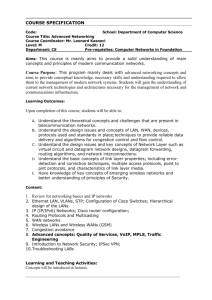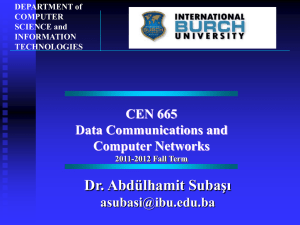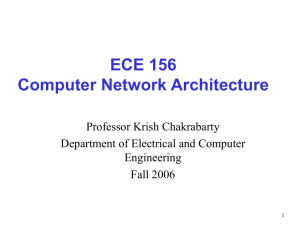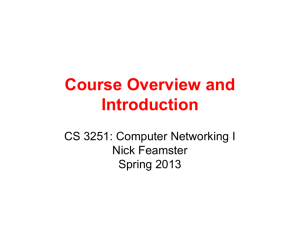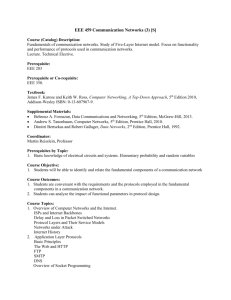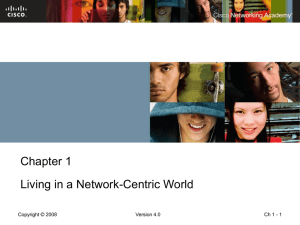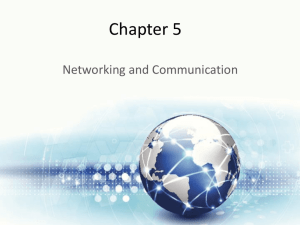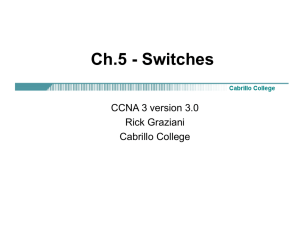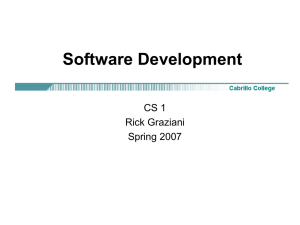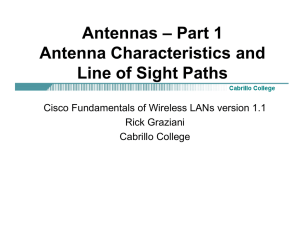Chapter 1 Powerpoint
advertisement
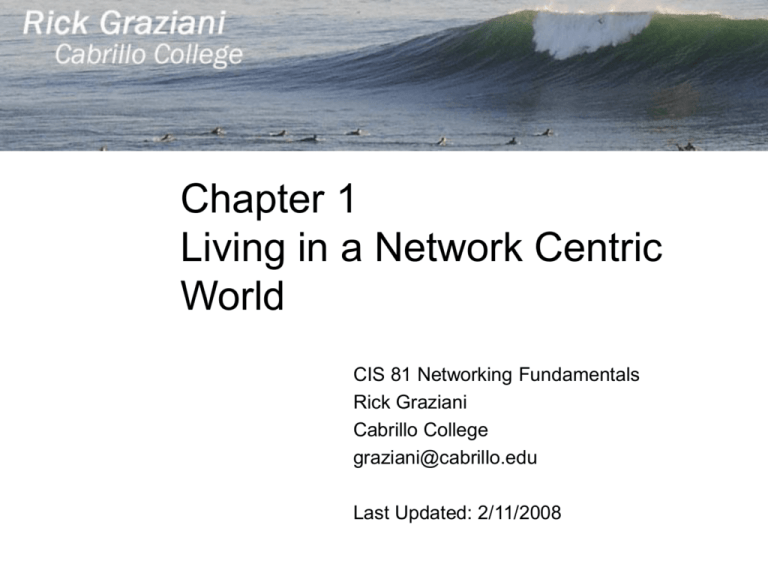
Chapter 1 Living in a Network Centric World CIS 81 Networking Fundamentals Rick Graziani Cabrillo College graziani@cabrillo.edu Last Updated: 2/11/2008 This Presentation For a copy of this presentation and access to my web site for other CCNA, CCNP, and Wireless resources please email me for a username and password. Email: graziani@cabrillo.edu Web Site: www.cabrillo.edu/~rgraziani 2 Overview Remember, we are just beginning to herd the cats. Much of this will become clearer LATER! The more we learn, the more all of this will come into focus! 3 Introduction The globalization of the Internet has succeeded faster than anyone could have imagined. The manner in which social, commercial, political and personal interactions occur is rapidly changing to keep up with the evolution of this global network. 4 Network Centric World Using Networks in our lives 6 Using Networks in our work Networks are no longer just a luxury, but a necessity in conducting business for businesses, governments, educational institutions, etc. 7 Using Networks in our work 8 Using Networks in outside of work 9 Networks – Behind the scenes More than just connecting cables… (that’s the easy part) Today’s networks are complex and sophisticated combination of protocols, software, hardware, algorithms, configurations, policies, and more Security Privacy 24 x 7 availability and access Quality of Service Video on Demand Voice over IP (over the Internet) Redundancy and backup Mission critical applications Productivity and user expectations Wireless 10 Networks Supporting the Way We Live The original idea about networks and the Internet was about sharing computer resources – computer-to-computer communications. That quickly changed to people-to-people communications. Early networks were limited to character-based information. Communications between computers was not common nor easy to do. 11 Networks Supporting the Way We Live http://www.youtube.com/watch?v= CQzUsTFqtW0 Today’s networks carry between many different types of devices: Voice video streams Text graphics 12 The Global Community Technology helps to create a world in which national borders, geographic distances, and physical limitations become less relevant. 13 Networks are integral in our daily lives http://www.youtube.com/watch? v=fQKNvPn3V8&mode=related&search= 14 15 Examples of Today’s Popular Communication Tools Instant Messaging: AOL AIM and MSN Messanger Developed from earlier Internet Relay Chat (IRC) Incorporates features such as: file transfer voice video communication (web cam) chat 16 Weblogs (blogs) Weblogs (Blogs) are web pages that are easy to update and edit. Unlike commercial websites, which are created by professional communications experts, blogs give anyone a means to communicate their thoughts to a global audience without technical knowledge of web design. 17 Wikis Wikis are web pages that groups of people can edit and view together. There is a public wiki, called Wikipedia, that is becoming a comprehensive resource - an online encyclopedia - of publicly-contributed topics. Private organizations and individuals can also build their own wikis to capture collected knowledge on a particular subject. 18 Podcasting Podcasting is an audio-based medium that originally enabled people to record audio and convert it for use with iPods. Podcasting allows people to deliver their recordings to a wide audience. The audio file is placed on a website (or blog or wiki) where others can download it and play the recording on their computers, laptops, and iPods. 19 Collaboration Tools Collaboration tools give people the opportunity to work together on shared documents. Without the constraints of location or time zone, individuals connected to a shared system can speak to each other, share text and graphics, and edit documents together. 20 Supporting Learning E-Learning On-line discussions and access to resources On-line assignments and assessments Blended distance learning 21 Packet Tracer Note: These screens are not related. 22 NetLab 23 Online Courseware 24 Networks Supporting the Way We Work Intranets, private networks in use by just one company, enable businesses to communicate and perform transactions among global employee and branch locations. Companies develop extranets, or extended internetworks, to provide suppliers, vendors, and customers limited access to corporate data to check order status, inventory, and parts lists. 25 Networks Supporting the Way We Play Email Personal Web Sites Sharing photos and videos (YouTube) Travel: Expedia, Priceline, Travelocity, etc. IM Gaming 26 Communication What is Communications? Different expectations depending on whether we are chatting via the Internet or participating in a job interview. Before beginning to communicate with each other, we establish rules or agreements to govern the conversation. These rules, or protocols, must be followed in order for the message to be successfully delivered and understood. A protocol is nothing more than an agreement or rules to govern a way of communicating. Among the protocols that govern successful human communication are: An identified sender and receiver Agreed upon method of communicating (face-to-face, telephone, letter, photograph) Common language and grammar Speed and timing of delivery Confirmation or acknowledgement requirements 28 Protocol Before beginning to communicate with each other, we establish rules or agreements to govern the conversation. These rules, or protocols, must be followed in order for the message to be successfully delivered and understood. A protocol is nothing more than an agreement or rules to govern a way of communicating. 29 Quality of Communications Examples An identified sender An identified receiver Confirmation or acknowledgement requirements Format or order of information 30 Quality of Communications Internal factors: nature of the message itself. The size of the message The importance of the message 31 Network as a Platform What is Networking? Networking - the interconnection of workstations, peripherals, terminals and other devices. Whatis.com: “In information technology, networking is the construction, design, and use of network, including the physical (cabling, hub, bridge, switch, router, and so forth), the selection and use of telecommunication protocol and computer software for using and managing the network, and the establishment of operation policies and procedures related to the network.” 33 Devices on a network 34 Network Medium 35 Network Applications and Protocols Some other applications: DNS, DHCP, HTTP, SMTP, FTP Some other protocols TCP/IP suite of protocols Ethernet Routing protocols 36 Converged Networks Traditional telephone, radio, television, and computer data networks each have their own individual versions of the four basic network elements. Technology advances are enabling us to consolidate these disparate networks onto one platform - a platform defined as a converged network. 37 Converged Networks 38 Architecture of the Internet Network Architecture A fault tolerant network is one that limits the impact of a hardware or software failure and can recover quickly when such a failure occurs. A scalable network can expand quickly to support new users and applications without impacting the performance of the service being delivered to existing users. 40 Quality of Service Voice and live video transmissions require a level of consistent quality and uninterrupted delivery that was not necessary for traditional computer applications. 41 Security The security and privacy expectations that result from the use of internetworks to exchange confidential and business critical information exceed what the current architecture can deliver. 42 Circuit Switched Connection-oriented Networks Setup process Temporary circuit Failure in path, connection terminated Limited number of circuits Because resources at the various switching locations are dedicated to providing a finite number of circuits, the quality and consistency of messages transmitted across a connection-oriented network can be guaranteed. 43 Packet Switched Connectionless Networks Single message can be broken into multiple message blocks (packets). Packets containing addressing information indicates both their origination point and their final destination. Packets, can be sent through the network along various paths, and can be reassembled into the original message upon reaching their destination. (connectionless) 44 Circuit Switched (connection oriented) vs Packet Switched (connectionless) Circuit Switched Dedicated circuit Guaranteed level of service (bandwidth) - QoS Inefficient use of medium Single path, no redundancy Packet Switched Shared circuit Messages divided into packets More efficient use of medium Redundancy, multiple possible paths 45 Scalable Network Architecture Tier-1 providers: ISPs provide national and international connections. (Verizon, Sprint, AT&T, NTT, cable systems, etc.) Tier-2 providers: Provide regional service, pay Teir-1 for connectivity. Tier-3 providers: Provide service directly to end users, usually connected through Tier-2 providers. 46 Quality of Service 47 Quality of Service 48 QoS Matters Without properly designed and implemented QoS mechanisms, data packets will be dropped without consideration of the application characteristics or priority. Dropped distress call to an emergency response center, or of a lost control signal to an automated piece of heavy machinery. A key responsibility for the network managers is to establish a QoS policy. 49 Providing Network Security Securing a network infrastructure includes the physical securing of devices that provide network connectivity and preventing unauthorized access. Content security refers to protecting the information contained within the packets being transmitted over the network and the information stored on network attached devices. 50 Trends in Networking Trends Three major trends that are contributing to the future shape of complex information networks: Increasing number of mobile users Proliferation of network capable devices Expanding range of services 52 Career Opportunities Information Technology and networking careers are growing and evolving as fast as the underlying technologies and services. As networks increase in sophistication, the demand for people with networking skills will continue to grow. 53 IT is not the network, it is the users The IT (Information Technology) department is not the network. The network is the users and their: Needs Expectations Requirements Uses It is not up to the IT department to decide how the network gets used, but how to meet the user requirements and at the same time provide the security and quality of service necessary. If IT doesn’t find a way, the users will! 54 A shift in attitude If an old school IT staff doesn’t change, they will be replaced. There is too much at stake and there are IT people who can meet the needs of the users and the organization. Old school IT doesn’t work any more. We don’t support MACs. We can’t allow that application on our network. We can’t give them access on our network. We have too much to do already. We don’t support that. You don’t know about networks, so we can’t do that. That would breach our security. 55 Technical and Soft Skills Networking professionals need more knowledge and skills today than ever before. Tomorrow’s IT professionals will need even more. Just as important, and sometimes even more important are the soft skills: Attitude Enthusiasm Communications skills Professionalism (conduct, etc.) A professional within the organization. 56 Chapter 1 Living in a Network Centric World CIS 81 Networking Fundamentals Rick Graziani Cabrillo College graziani@cabrillo.edu Last Updated: 2/11/2008
